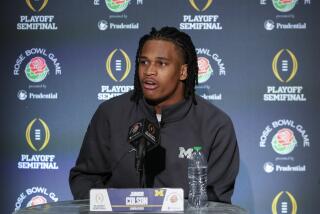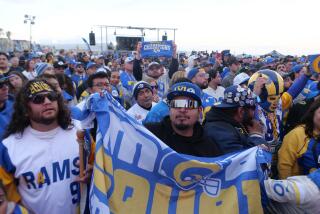Draft: Underclassmen, but Not Undertalented
NEW YORK
One of the NFL’s prominent personnel men was talking about the 35 juniors who make Sunday’s NFL draft one of the deepest in a decade.
“I don’t like it,” he said. “I’d much rather have a 23-year-old with two or three solid years of college behind him than a 20-year-old with a year-and-a-half’s experience.”
Does that mean, he was asked, that he wouldn’t pick a junior if a good one was available.
“Whoa!” he almost yelled. “I didn’t say that!”
The 1990 draft, which begins at noon EDT and continues Monday with the final seven or eight rounds, is the first in which the NFL has indiscriminately allowed in underclassmen, following a pattern established by pro basketball nearly two decades ago.
Like the man cited above, nearly everyone from commissioner Paul Tagliabue down say he wishes the kids would stay in school.
Like the man cited above, nearly everyone is excited about the talent.
Starting with quarterbacks Jeff George of Illinois and Andre Ware of Houston and linebackers Junior Seau of Southern California and Keith McCants of Alabama, perhaps four of the first seven players picked will be underclassmen.
As many as 10 could go on the first round.
“When you squeeze a lot of next year’s draft into this year’s, it’s made it more lucrative,” says Pittsburgh coach Chuck Noll, echoing his colleagues.
“But it will be weaker down the line. I would prefer the juniors stay in there and get an extra year of experience and an extra year of time. Some of the reasons they have for coming out early aren’t real good. But they’re there and we’ll make decisions on them.”
The exodus makes the draft the deepest in at least five years and perhaps the best since 1983, when the first round included John Elway, Eric Dickerson, Curt Warner and Dan Marino, who lasted until the 27th pick. It’s richest in linebackers and running backs thinnest in offensive linemen and defensive backs.
“What all these juniors do is make it stronger down the line,” says George Young, general manager of the New York Giants. “Now you’re still going to have good players available in the fourth round, although if you take one of the kids, you’ll have to take a couple of years to break him in.”
The first round has only 25 picks because three teams, Dallas, Phoenix and Denver gave up theirs to take Steve Walsh, Timm Rosenbach and Bobby Humphrey respectively in last year’s supplemental draft.
Dallas’ choice of Walsh, whom they’ve been trying to peddle ever since, was particularly painful since, at 1-15, the Cowboys would have had the first pick this year. Denver got a bargain in Humphrey, who rushed for 1,151 yards would never have been available with the next-to-last pick this year.
Cracks in the all-seniors policy have been appearing for years--few underclassmen who applied for the supplemental draft have been turned down in the last few years.
Tagliabue, commissioner Pete Rozelle’s top legal adviser, had a lot to do with that, arguing that the NFL would lose any court battle on the simple grounds that it was denying someone a chance to earn a living.
Then last year, Barry Sanders, the Heisman Trophy winner, became the first three-year junior allowed in the regular draft and became offensive rookie of the year. This year, his first as commissioner, Tagliabue simply opened the doors, allowing in anyone who entered college in September, 1987 or before--if he renounced any remaining college eligibility.
Another factor is the labor impasse, which has convinced many agents that the owners are about to impose a rookie salary scale that would mean the end of the seven-figure contracts that have become standard the past few years.
“It’s being driven strictly by player agents looking for more money for themselves,” says Carl Peterson, general manager of the Kansas City Chiefs. “For a lot of them, the money they thought will be there may not be.”
But many of the juniors, quite frankly, need the money, like Lamar Lathon, a linebacker from Houston and a likely first-rounder, who wants to help his sister go through a treatment for crack addiction.
Lathon is one of many linebackers who represent the cream of this draft.
The best was supposed to be McCants, the Alabama junior who was considered the sure No. 1 pick when he announced he was coming out and was described by none other than Lawrence Taylor as “the Lawrence Taylor of the ‘90s.”
But McCants has been derailed by a series of circumstances ranging from his choice of an agent--Lance Luchnick--to a rather mediocre workout in which floating chips were discovered in his knee. Now he could drop down to sixth or lower, potentially costing him $1 million or more.
“I still think he’s a terrific football player, and I don’t think anybody questions how good he was in college or how good he could be in the pros,” says Bobby Beathard, now the general manager at San Diego after a dozen years with the Redskins.
“But from the workout, you get the idea this kid is not coming into the NFL saying, ‘I’m doing everything I can to be worthy of the No. 1 pick.”’
In fact, McCants probably won’t be the first linebacker taken and could fall down as far as tenth. Seau, the USC linebacker, will probably go to New England on the third pick.
Other potential first-round linebackers include Lathon; James Francis of Baylor; Chris Singleton of Arizona; Renaldo Turnbull of West Virginia, a hybrid linebacker-defensive end; Percy Snow of Michigan State and perhaps Ron Cox of Fresno State; Terry Wooden of Syracuse; Darion Conner of Jackson State and Tony Bennett of Mississippi.
Like McCants, Seau and Lathon, Cox is a junior.
Then there are the running backs, a skill position that takes less time to learn. Sanders proved that last season when he gained 1,470 yards for the Lions.
Blair Thomas of Penn State, a senior, is expected to be the second choice--by the New York Jets.
But other seniors have been pushed lower into the round by the juniors, including Darrell Thompson of Minnesota and Anthony Thompson of Indiana, who were thought to be top-five picks last season. Still, the Thompsons, Harold Green of South Carolina and Steve Broussard of Washington State, all seniors, could go in the first round.
The junior running backs are led by Rodney Hampton of Georgia, Emmitt Smith of Florida, Leroy Hoard of Michigan and perhaps the riskiest prospect of the draft, Reggie Cobb of Tennessee. No one doubts Cobb’s talent, but everyone’s scared of him because he was dropped from college after failing a drug test the third time.
“He’s intriguing, a hell of an athlete,” one personnel director says of Cobb. “The question is that there obviously are questions about him.”
Other positions are thinner--in fact, most of the underclassmen are skill players. “You notice that there aren’t many big guys there,” Young says. “It takes much longer to develop them.”
Tackle Richmond Webb of Texas A&M; and center Bern Brostek of Washington are considered the only first-round offensive linemen.
The best defensive line prospect is Miami’s Cortez Kennedy with Ray Agnew of North Carolina State, Dennis Brown of Washington, Oliver Barnett of Kentucky and Jeff Alm of Notre Dame also potential first rounders. The only top underclassmen is Marc Spindler of Pitt and his stock has dropped because of questions about a bad knee.
Ware and George are the only sure first-round quarterbacks, although Scott Mitchell of Utah and perhaps Cary Conklin of Washington could also squeeze in.
Other potential first-rounders include wide receivers Reggie Rembert of West Virginia, Alexander Wright of Auburn and Greg McMurtry of Michigan; defensive backs J.D. Williams of Fresno State, Ben Smith of Georgia, Pat Terrell of Notre Dame and Vince Buck of Central State in Ohio; defensive end Rob Burnett and linebacker Terry Wooden of Syracuse and guard Mohammed Elewonibi of Brigham Young.
Following the Falcons and Jets, the order in the first round is New England, Tampa Bay, San Diego, Chicago, Detroit, Seattle, Miami, Seattle again, the Raiders, Cincinnati, Kansas City, New Orleans, Houston, Buffalo, Pittsburgh, Green Bay with two picks, Atlanta again, Dallas, Philadelphia, the Rams, the Giants and San Francisco.
Washington is without a first-round pick for the 21st time in 24 years, having traded it to Atlanta for Gerald Riggs; Indianapolis gave its pick to Seattle for Fredd Young; Minnesota surrendered its first-rounder to Dallas for Herschel Walker and Cleveland gave its to Green Bay for the right to take Lawyer Tillman in the second round last year.
More to Read
Go beyond the scoreboard
Get the latest on L.A.'s teams in the daily Sports Report newsletter.
You may occasionally receive promotional content from the Los Angeles Times.










